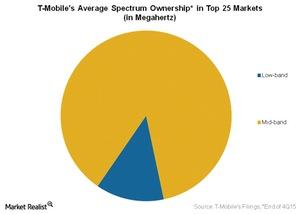What’s the Significance of T-Mobile’s Low-Band Spectrum?
T-Mobile has been adding low-band spectrum holdings.
March 24 2016, Updated 12:06 p.m. ET

T-Mobile’s low-band spectrum holdings
In the last part of the series, we learned that the FCC’s (Federal Communications Commission) incentive auction for the 600 MHz (or megahertz) wireless spectrum holdings is scheduled to begin on March 29, 2016, as per the commission. We also saw that T-Mobile (TMUS) and Sprint (S) do not have significant holdings in the coverage spectrums compared to Verizon (VZ) and AT&T (T).
T-Mobile has been adding low-band spectrum holdings. The carrier had low-band spectrum holdings in the 700 MHz A-Block spectrum spanning around 210 million people at the end of 4Q15. As per T-Mobile’s CFO, J. Braxton Carter, at the Deutsche Bank Media, Internet, and Telecom Conference on March 7, the carrier has holdings in the 700 MHz A-Block spectrum spanning 258 million people.
Deployment on the low-band spectrum positively impacts T-Mobile’s churn
During the Deutsche Bank Media, Internet, and Telecom Conference, Carter highlighted a key benefit the company is witnessing from deployment on the low-band spectrum. According to Carter, “The early indications are, again much better retention in our low-band deployments and that’s both more from a rural geography suburban coverage, but also in the major metropolitan areas, because the low band penetrates these large concrete structures in a much more efficient manner.”
Instead of getting direct exposure to companies in the US telecom industry, you could consider diversified exposure to the space by investing in the SPDR S&P 500 ETF (SPY). The ETF held a total of ~2.4% in US telecom companies at the end of December 2015.
